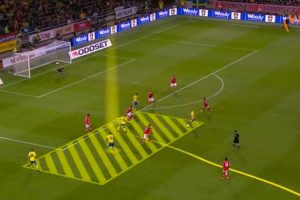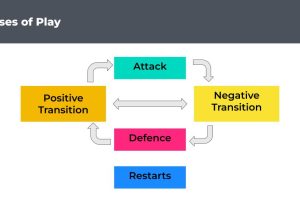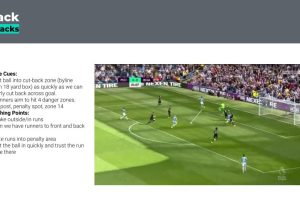Video Analysis for Soccer Coaches: Essential Techniques and Tools for Success
Video analysis has become an essential tool for soccer coaches looking to enhance their team’s performance and gain a competitive edge. By carefully studying game footage, coaches can identify specific areas that need improvement, reveal hidden patterns in their opponents’ tactics, and develop tailored strategies to address these weaknesses. Moreover, this evidence-based approach empowers coaching staff to make informed decisions and better communicate with their athletes during training sessions and on the pitch.
Understanding the basics of video analysis involves learning how to best review and annotate match footage, as well as the importance of data-driven insights in game preparation and debriefing. Additionally, the role of a video analyst in a soccer club has evolved to become a crucial part of a team’s performance support structure. Choosing the right video analysis app for a team is vital to ensure seamless integration and user-friendly features that support efficient workflow and analysis.
Key Takeaways
- Video analysis is a vital tool for soccer coaches to improve team performance and develop tailored strategies.
- A strong understanding of video analysis basics and the role of a video analyst is essential for success.
- Choosing the right video analysis app for a team enhances efficiency and supports seamless integration in the coaching process.
Importance of Video Analysis for Soccer Coaches
Video analysis plays a crucial role in the modern soccer coaching field, offering valuable insights that can significantly improve team performance. By investing time and resources into this kind of analysis, coaches can make more informed decisions and better address their team’s needs.
One primary advantage of video analysis is identifying areas for improvement within a team. By studying player movements, coaches can detect weaknesses in individual players or the team as a whole and make adjustments accordingly. Additionally, video analysis helps coaches assess tactical strategies and evaluate their effectiveness in real-time situations.
Coaches can also use video analysis to study opponents’ playing styles and strategies, allowing them to better prepare their team for upcoming matches. By analyzing the strengths and weaknesses of individual opponents, coaches can devise strategies to exploit these vulnerabilities and increase their own team’s chances of success.
Moreover, video analysis provides a platform for self-reflection and learning. Players can watch their performances, recognize their mistakes, and digest constructive feedback from their coaches. This process fosters continuous improvement and encourages a growth mindset within the team.
In turn, video analysis also helps enhance communication between coaches and players. By visually highlighting strengths or areas of concern, coaches can offer more precise and targeted feedback, promoting efficient learning and enhanced understanding.
Overall, incorporating video analysis into a soccer team’s coaching regime is a worthwhile investment. It empowers coaches to better understand their team, develop informed tactics, analyze opponents, and foster a culture of continuous learning and improvement.
Understanding the Basics of Video Analysis
Video analysis has become an essential tool for soccer coaches in recent years, offering valuable insights into team and player performance. The process begins with capturing footage of games or training sessions with high-quality cameras. Modern technology enables coaches to access various angles, which can provide a comprehensive understanding of the game.
The role of an analyst is crucial in this process, as they are responsible for gathering and interpreting the data collected from the captured footage. They use their expertise to analyze the video, focusing on specific aspects to help identify tactical patterns, strengths, and weaknesses. This information is then shared with the coaching staff, who can make informed decisions based on the findings.
Data is a critical component of video analysis. It goes beyond raw numbers, delving into the details of player movement and positioning, and various team statistics. The data is extracted using specially designed software, which can offer insights such as heat maps, possession statistics, and tracking player movement throughout games or training sessions.
A significant advantage of video analysis is its ability to adapt to different technological advancements. Coaches and analysts can now use various tools, including specialized cameras like drone or panoramic cameras, to obtain a broader perspective of the game. These innovative devices offer an unparalleled view of the field, enabling in-depth analysis of player and ball movement.
In conclusion, the basics of video analysis revolve around capturing the footage, employing an analyst to assess the data, and leveraging technology to obtain essential information. By understanding these fundamentals, soccer coaches can effectively use video analysis to enhance their team’s performance and maintain a competitive edge.
Video Analysis in Training Sessions
Video analysis has become an essential tool for soccer coaches looking to improve their team’s performance during training sessions. By carefully reviewing footage of practices and matches, coaches can identify areas of strengths and weaknesses, both for the team as a whole and for individual players. This information can then be used to inform tactics and make adjustments on the training ground.
In a typical training session, coaches can use video analysis to review the players’ movement, passing, attack, and defending techniques. By analyzing the footage, it becomes possible to spot recurring patterns or issues that need to be addressed during practice. For example, if a team consistently fails to maintain its shape when transitioning from attack to defense, a coach can use this insight to develop specific drills to remedy the issue.
Additionally, video analysis helps coaches assess individual players’ performance. By studying the footage, they can identify strengths and weaknesses in each player’s technique, positioning, and decision-making. This information can be used to tailor individual training plans, addressing specific areas for improvement.
Using video analysis on the pitch during practice sessions also allows coaches to provide immediate feedback to players. For instance, if a coach notices a player consistently making poor decisions in attack, they can pause the session, review the video with the player, and discuss potential improvements. This real-time analysis and feedback can help players better understand their mistakes and work on correcting them promptly.
One important aspect when implementing video analysis in training sessions is communication. Coaches should present their findings in a clear and concise manner, ensuring that players understand the adjustments they need to make. By focusing on key points and avoiding information overload, coaches can ensure that players are engaged and receptive to the feedback provided.
In conclusion, video analysis is a valuable tool for soccer coaches, helping to assess team and individual performance, inform tactics, and provide real-time feedback during training sessions. By incorporating this technology into their practice routines, coaches can significantly enhance their team’s performance on the pitch and drive continual improvement for both the team and individual players.
Role of the Video Analyst in a Soccer Club
A video analyst plays a crucial role in a soccer club by providing valuable insights on team and player performances. By leveraging video analysis tools, they help the coaching staff to better prepare for matches, make informed decisions during games, and develop tailored training sessions.
The primary responsibility of a video analyst is to dissect game footage to identify the strengths and weaknesses of their own team, as well as those of their opponents. This includes analyzing team and player tactics, playing styles, set pieces, and individual skills. By doing so, they enable the coaching staff to devise effective game plans and counter-strategies.
A video analyst often works closely with the head coach and other staff members to ensure that the data collected is relevant and actionable. For instance, the analyst may collaborate with the coaching team to work on specific training drills that address identified weaknesses. Additionally, they might share their findings with the players, creating a culture of constant learning and self-improvement within the club.
In modern soccer clubs, the integration of technology is key to maintaining a competitive edge. Video analysts are instrumental in adopting innovative technologies such as Hudl to collect and analyze visual data. They also contribute to the development and implementation of specialized team and player performance tracking systems, like video-based player tracking and positioning analysis.
Besides providing tactical insights, a video analyst can help identify talent for recruitment. By analyzing videos of potential new signings, these analysts provide invaluable input into the scouting process, assessing the suitability of prospective players for the team’s style and requirements.
In conclusion, the role of a video analyst has become increasingly significant in soccer clubs. Their expertise in using video analysis tools and generating actionable insights helps coaches make informed decisions, leading to improved team performance and success on the field.
Choosing the Right Video Analysis App for Your Team
Selecting the appropriate video analysis app for your soccer team is crucial for maximizing the potential of technology in enhancing performance. With several options available, it’s essential to consider the team’s needs and resources before making an investment. Here are some factors to consider when choosing the right video analysis app.
First and foremost, the app should be user-friendly and easy for coaches and players to navigate. Additionally, it should provide the ability to analyze, edit, and share game footage effortlessly. Some popular apps such as myDartfish Express and Hudl offer modern interfaces and comprehensive features that cater to the needs of soccer teams at different levels.
Secondly, the app must be compatible with various recording technologies, such as AI-powered camera systems like Pixellot and Veo. These camera systems capture high-quality game footage, enabling detailed video analysis. Integrating these technologies will significantly enhance the app’s effectiveness in providing valuable insights to coaches and players.
Considering the budget constraints of your club is vital when selecting a video analysis app. Some platforms require a significant investment upfront, while others offer subscription-based pricing. Balancing the features offered and the available resources is key to ensure the tool fits the club’s long-term goals.
Lastly, the app should be adaptable and scalable, allowing it to grow with your team. As the technology evolves, the app should be able to accommodate new advancements and remain relevant for the club’s future needs.
By carefully evaluating various factors, choosing the suitable video analysis app will empower your soccer team to thrive and reach new heights in performance.
Effective Utilization of Video Analysis Playlists
Video analysis in soccer has become an essential tool for coaches and players alike in recent years. One critical aspect of video analysis is the creation and utilization of playlists. Playlists serve as a powerful method for categorizing and organizing video clips in a way that makes reviewing them more efficient and targeted.
A soccer coach can create playlists to focus on various aspects of the game, such as team tactics, opponent analysis, and individual player performance. By dividing video clips into these categories, coaches can quickly access relevant footage and make better-informed decisions.
When working on team tactics, playlists can help coaches identify patterns in both their own team’s play and the opposition’s. These playlists can highlight areas where the team performs well or needs improvement, enabling coaches to provide specific feedback during training sessions. Additionally, playlists can be used for preparing the team for upcoming games by analyzing the strategies of future opponents.
For individual players, playlists can be an invaluable resource in tracking their progress and adjusting their skill development. A coach can create a playlist for each player, focusing on strengths, weaknesses, and areas for growth. This allows the player to gain a thorough understanding of their performance and receive tailored guidance from the coach.
In summary, using video analysis playlists effectively can vastly improve a soccer coach’s ability to communicate and instruct their team on tactics, opponent strategies, and individual performance. By efficiently organizing clips into targeted playlists, coaches can optimize their use of video analysis and ultimately enhance the overall performance of their team.
Frequently Asked Questions
Which video analysis software is best for soccer coaches?
There are several video analysis software options available for soccer coaches, such as Dartfish and Athlyzer. The choice of the best software depends on the needs and budget of the coach. It’s important to research various tools and determine their features and pricing before making a decision.
What do soccer analysts typically earn as a salary?
Soccer analysts’ salaries can vary greatly depending on factors such as their experience, the club or organization they work for, and the country in which they reside. Entry-level analysts may earn a modest salary, while experienced professionals at top clubs may receive higher compensation. There is no universally accepted salary range for soccer analysts, so it’s essential to explore specific job roles and requirements.
Are there any free soccer tactical analysis software options?
While many video analysis software options have a cost associated with them, there are some free or lower-cost alternatives available. Coaches may leverage open-source tools or online resources for basic video analysis. However, keep in mind that free options may not offer the same level of features and support as paid software.
What is the role of a video analyst in soccer?
A video analyst in soccer works closely with coaches and players to analyze match footage, identify strengths and weaknesses, and develop strategies based on their findings. Their role may include breaking down individual player performance, identifying patterns and trends in opponent tactics, and helping the coaching staff devise game plans tailored to the specific opposition.
How can soccer coaches leverage video analysis for improvement?
Soccer coaches can leverage video analysis by studying their team’s performance, analyzing individual player skills, and identifying areas of improvement. Through in-depth analysis, coaches can gain insights into their tactics, formations, and overall team dynamics, allowing them to make informed decisions for training and match preparation. Video analysis can also be utilized to prepare for upcoming opponents by studying their tactical patterns, strengths, and vulnerabilities.
Are there any courses for soccer video analysis?
Yes, there are courses available for soccer video analysis, both online and in-person. These courses typically cover topics such as how to use specific software, understanding key performance indicators, and best practices for analyzing match footage. It is essential to research and select the appropriate course based on your specific needs, goals, and resources.






